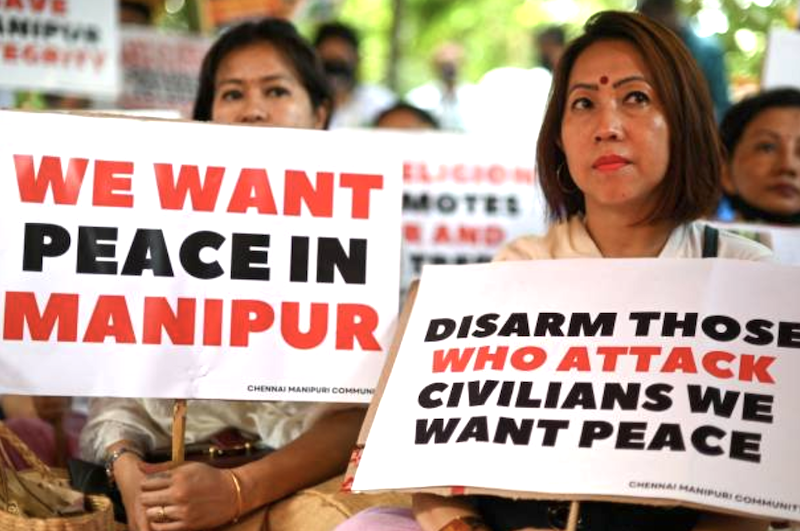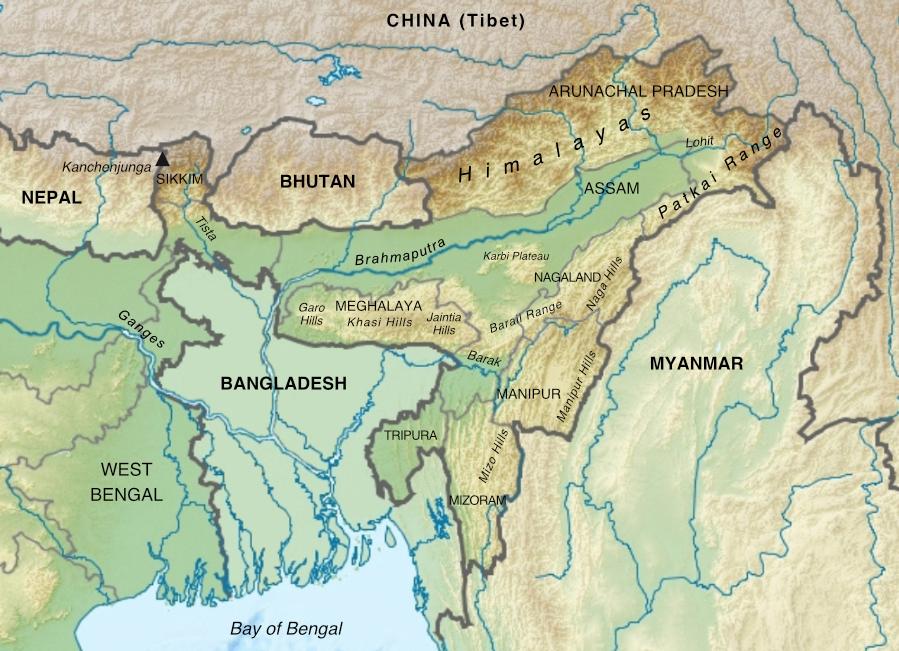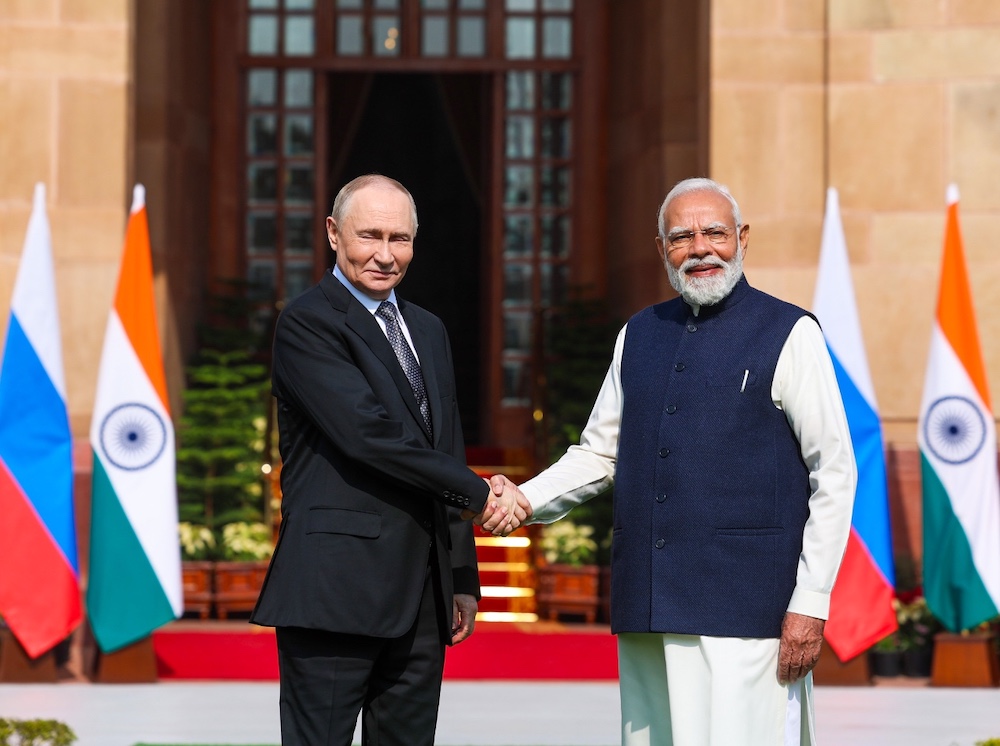 Manipuri women in Chennai during a vigil calling for peace in their state. (Photo via Facebook)
Manipuri women in Chennai during a vigil calling for peace in their state. (Photo via Facebook)
The Manipur ethnic violence, which started on May 3, has claimed over 150 lives and displaced more than fifty thousand people, if not more, so far. Although the intensity of the violence seems to have ebbed, it is still going on claiming, maiming, and displacing even more people. The violence has deepened already existing fault lines between communities, especially the dominant Meitei people and the tribal Kuki-Zo communities. And the chasm between them on geographical and religious lines is growing.
Currently, the state practically stands divided into two regions with a buffer zone, an appreciated security need, which also symbolises the widening distrust between the ethnic communities. Because of growing distrust and safety concerns, state employees were reluctant to join duties except in respective community areas even after the June 26 government’s that warned “no work, no pay”. This forced the chief minister N Biren Singh-led government to tweak the order and allowed the employees to join duties as per their preference.
This is a step forward to restore trust in the administration, but interestingly, it is unintentionally reinforcing a separate administrative jurisdiction. And this comes in the backdrop of the rising demand for a separate administration by the Kuki-Zo MLAs, including seven from the ruling BJP, for the state’s hill districts. According to several media reports, none of these MLAs attended the July 13 meeting, which was presided by the chief minister to discuss measures for the restoration of peace and return of normalcy in the state.
The absence of the MLAs representing hill districts is an indicator that all is not well within the Manipur government. When public representatives are not on the same page for quelling violence and restoring peace, how will they motivate their communities to forget and forgive the scars of violence to restore peace? Even after the meeting, news of reports of violence and exodus of violence-affected people kept coming in at a rapid pace. Amid this, reports also stated that heavily armed militants have started crossing across the border from Myanmar into India and taking part in the intercommunity clashes in Manipur.
Taking a serious note of this the foreign minister, S Jaishankar, during his July 16 “12th Foreign Ministers’ Meeting of the Mekong Ganga Cooperation Mechanism” meeting with his Burmese counterpart, Than Swe, in Bangkok, raised the issue. Jaishankar reportedly told Than Swe that the peace in the border areas between the two countries was “seriously disturbed” and “actions that aggravate the situation” must be stopped. It may be noted that after the Myanmar military junta removed the elected government of Aung San Suu Kyi in February 2022, thousands of civilians have joined in an armed insurgency against the regime, which has completely destabilized the country.
Earlier, the defence secretary, Giridhar Armane, also visited Myanmar where he is believed to have discussed the transborder security situation with officials there with respect to the Manipur violence.
Read also: Amid Manipur ethnic violence, defence secretary visits Myanmar
Sad conclusion that even after 90 days have passed since the violence started; Manipur continues to bleed while peace remains elusive.
Manipur blocked the internet immediately after the violence started, on May 3. The government said the ban was to stop the spread of rumour mongering and fake news, which may lead to more violence. This is understandable. However, it also has a flip side. It also suppressed news and reports of the countless atrocities that were carried out on innocent people, especially on women, from going out of the state.
Recently, an amateur video clip of two women being paraded naked while being molested by a mob and being led to an open field for allegedly gang-raping them managed to “leak” out of the state. Immediately, it was widely circulated on social media and viewed by countless Indians across the country triggering a national outrage. That the incident, which is now reported to have taken place on May 4 but saw the light of day only now, is deplorable.
After the national outrage, Biren Singh said “there are hundreds of similar FIRs here,” although he vowed to punish the perpetrators in the strictest possible way.
The incident was so horrific and deplorable that the Supreme Court took suo moto cognizance of the video. It compelled the chief justice of India, DY Chandrachud, to say: “What matters is that this is simply unacceptable. This is the grossest human rights violation. We will give government a little time to take action, or we will take action.”
#BREAKING Supreme Court directs Union and State government to take steps against the videos of women being stripped and paraded in #Manipur.
— Live Law (@LiveLawIndia) July 20, 2023
CJI DY Chandrachud remarks "We will give a little time for government to take action otherwise we will step in."#SupremeCourtOfIndia pic.twitter.com/cjEZ5xBRgm
The incident points to not only the total failure of the state government to ensure safety of people, especially women, but also tells the story how the internet ban in the state has kept the rest of the country in the dark on what was happening in Manipur.
No to Whataboutery in Manipur incident
— Bar & Bench (@barandbench) July 31, 2023
"We cannot justify what happened in Manipur by saying that this and this happened elsewhere": CJI DY Chandrachud#ManipurVoilence #SupremeCourt
Read more here: https://t.co/7xjrxLevWW pic.twitter.com/RuZIFDT2d1
What is the solution to the Manipur imbroglio?
There is no set-piece and copybook solution to tame the monster of violence ravaging Manipur. However, peace is achievable, provided statesmanship overtakes myopic political vision aimed at politics of polarisation for electoral benefits. Restoration of peace in Manipur requires patience and statesman-like vision, which presently seems to be lacking in the state as well as the central leadership.
Read also: Manipur crisis will end only if government sheds its parochial vision
The steps to quell violence and restore peace must be both on the external and internal front. The environment existing at the borders (Manipur borders Myanmar) have internal ramifications. As a first step, the Union home ministry may consider temporarily stopping the free movement regime, which exists between India and Myanmar. It may then simultaneously carry out a holistic and practical operational analysis of the India-Myanmar border to stop infiltration of extremists and militants sneaking through the porous border and strengthen border security by plugging gaps and infiltration routes.
The Myanmar border needs reassessment considering its porosity and large gaps, which facilitate illegal back-and-forth movement and illegal migration from Myanmar. The Centre may look for alternatives for border security and in the present circumstances Border Security Force with professional expertise of guarding two highly volatile borders against Pakistan and Bangladesh seems to be the best bet. (Currently, the Assam Rifles oversees the border security in the India-Myanmar border.)
On the internal front, the measures to restore peace and create harmony between communities further must be twofold, that is: a. strengthening the internal security regime and b. take administrative and political measures to fulfil aspirations of communities to reduce chasm and distrust.
The internal security grid needs strengthening by pumping in more battalions of the central armed police forces (CAPFs) to have an effective security umbrella across the state. Then, the buffer zones must be done away with because it gives an impression of no man’s land and strengthens the perception of a geographical division between communities.
The security forces need to pay special attention to the security of places of worship to win the trust of communities. There is a need to win the hearts and minds of the communities through positive actions to create a perception of goodwill between them. The security forces need to be tough and should not give any impression of weakness through actions, which are avoidable. The release of 12 apprehended militants of Kanglei Yawol Kanna Lup (KYKL) is a case in point. Such actions negatively affect the aura and standing of security forces in public esteem.
Read also: Women-led mob forces Indian Army soldiers to free top terrorist among 12
On the political front, the state political leadership needs to present a united front and shed linkages with groups seen as major players in present violence against communities. Listen to diverse political voices to create an environment of confidence. This will help gain trust and confidence of the people. The public representatives divided on ethnic lines under the compulsions of vote-bank politics is understandable. However, this has been stretched too far in Manipur’s case. They need to present a united front for giving peace a chance. They must work to soothe frayed tempers in the interest of peace and development of the state.
The central government must strongly say no to any division of state on geographic and religious lines. The Manipur (Hill Areas) District Councils Act, 1971, created six autonomous district councils and framed the rules for the Manipur assembly to govern and develop the councils. However, they need to be strengthened, made active with administrative structure for local governance and development in the spirit of Fifth and Sixth Schedule of the Constitution on priority.
The political executive needs to blur the ethnic aberrations in decision-making to slowly win back trust of communities to ensure triumph of peace over violence. It unfortunately doesn’t seem to be happening. The population composition in Manipur is in the ratio of about 53 per cent for Meiteis and about 47 per cent for Kuki-Zos and Nagas. The political parties need revisiting the political representation of different communities for a long-term solution to the Manipur problem.
On the administrative front, select the top echelons of the state administration and police on merit and professionalism. Do not tinker with the administrative and police structure amid crisis as it creates a perception of injustice and widens the distrust between communities.
Large quantities of arms and ammunition were taken away from the Manipur Police’s armouries. There must be tough action to recover these arms in the interest of peace. Additionally, those responsible for the laxity in security that resulted in the looting of the weapons to formant trouble need to be dealt with very strictly.
Read also: Mobs loot over 4,000 sophisticated weapons from police armouries
Armouries are supposed to be heavily fortified. Looting or simply handing over arms from armouries is a dead giveaway of the connivance of those responsible for security. Each arm and ammunition need to be accounted for and each such incident thoroughly investigated. The guilty must be strictly dealt with as per the law of land to send a strong message that messing up with security won’t be tolerated.
There is a need for aggressive peace posturing by all stakeholders to quell the cycle of violence in the interest of peace and stability in Manipur. The state government has failed to contain it. The undercurrents of unrest and tension between communities are very strong and have created a situation that the state government failed to address.
There is a need for robust administration, which can carry forward the good work of the security forces to bring back stability to Manipur. For that, the Union government should immediately step in and take over reigns of administration by imposing the president’s rule in state.
There is no easy solution to present Manipur imbroglio. It would require a long-term vision from the Centre to restore peace. Unless perception of an effective, honest, and impartial administration is created, peace will remain elusive from Manipur.
Disclaimer: The views expressed in the article are the author’s own and don’t necessarily reflect the views of India Sentinels.
Follow us on social media for quick updates, new photos, videos, and more
Twitter: https://twitter.com/indiasentinels
Facebook: https://facebook.com/indiasentinels
Instagram: https://instagram.com/indiasentinels
YouTube: https://youtube.com/indiasentinels
© India Sentinels 2022-23










